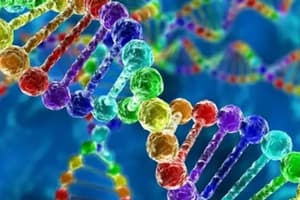Podcast
Questions and Answers
What is the primary determinant of biological sex in humans?
What is the primary determinant of biological sex in humans?
- Chromosomes (correct)
- Gender identity
- Hormonal makeup
- Secondary sexual characteristics
Which of the following is NOT a component of biological sex?
Which of the following is NOT a component of biological sex?
- Secondary sexual characteristics
- Gender identity (correct)
- Reproductive organs
- Hormonal makeup
How many chromosomes do humans typically have per cell?
How many chromosomes do humans typically have per cell?
- 48
- 44
- 46 (correct)
- 50
Which combination of sex chromosomes do females usually inherit?
Which combination of sex chromosomes do females usually inherit?
Which are the primary reproductive structures associated with each sex?
Which are the primary reproductive structures associated with each sex?
What is the function of testes in males?
What is the function of testes in males?
What is the role of estrogen and progesterone in the female body?
What is the role of estrogen and progesterone in the female body?
Which physical traits are considered primary sexual characteristics in females?
Which physical traits are considered primary sexual characteristics in females?
What distinguishes secondary sexual characteristics from primary sexual characteristics?
What distinguishes secondary sexual characteristics from primary sexual characteristics?
How do hormones contribute to the differentiation between male and female bodies?
How do hormones contribute to the differentiation between male and female bodies?
Which term refers to individuals who possess chromosomes, hormone levels, and external sexual characteristics that do not align with typical male or female definitions?
Which term refers to individuals who possess chromosomes, hormone levels, and external sexual characteristics that do not align with typical male or female definitions?
Why is understanding intersex conditions crucial?
Why is understanding intersex conditions crucial?
Flashcards are hidden until you start studying
Study Notes
Sex: Understanding Biological Sex
Biological sex is determined primarily by physical and genetic characteristics. It refers to the classification of an individual based on their reproductive organs, hormonal makeup, and secondary sexual characteristics. While often used interchangeably with gender identity, these two concepts differ fundamentally. Gender identity is the socially constructed role, behavioral expression, personal experiences, and internal sense of being female, male, both, or neither. In this article, we will explore various aspects of biological sex, including chromosomes, gonads, hormones, primary and secondary sexual characteristics, intersex individuals, and medical and legal implications related to sex assignment at birth.
Chromosomes
The vast majority of humans have forty-six chromosomes per cell. These chromosomes come in pairs - twenty-two pairs of non-gender chromosomes called autosomes and one pair of sex chromosomes. Two commonly known variations exist: XX and XY. Females typically inherit an XX combination from their parents, while males usually receive an XY combination. However, not all people fit neatly into these categories, which can lead to further exploration into intersex individuals.
Gonads
Gonads are the primary reproductive structures associated with each sex. Ovaries serve as the female's gonad, producing eggs during ovulation. Testes function similarly for males, generating sperm cells. Although gonads play significant roles in differentiating between male and female bodies, other factors contribute to this distinction, such as genetic predispositions and environmental influences.
Hormones
Hormones regulate development and function within our bodies. For example, estrogen and progesterone are essential for women's menstrual cycles and pregnancy. Meanwhile, testosterone supports the growth of specific tissues in males, like muscle mass and the vocal cords. Contrary to popular belief, hormones do not dictate strictly binary outcomes, but rather encourage a range of effects across a spectrum. A person's sexually dimorphic traits may not align perfectly with hormone levels due to genetic and environmental factors.
Primary Sexual Characteristics
Primary sexual characteristics are physical traits associated with reproductive functions specific to each sex. Females typically have breasts, which may vary from small to large depending on the individual's body type. Additionally, they grow pubic hair and develop uterine canal, fallopian tubes, and vagina during adolescence. On the other hand, males often experience deepening voices, facial hair growth, and development of testicles within the scrotal sac and penises during puberty. These primary sexual characteristics contribute to the differentiation between male and female bodies but do not encompass all aspects of biological sex.
Secondary Sexual Characteristics
Secondary sexual characteristics include features that distinguish adult males and females and develop after puberty. Some examples include women's widened hips, narrow shoulders, and extensive fat distribution across their bodies. In contrast, males showcase broader shoulders, narrow waists, and more symmetrical faces. However, like primary sexual characteristics, these differences exist along a spectrum, meaning individuals may exhibit varying degrees of such features based on genetics and environment.
Intersex Individuals
Intersex individuals possess chromosomes, hormone levels, and external sexual characteristics that do not align neatly with typical definitions of male or female. This can lead to challenges when assigning a sex at birth, particularly if medical intervention is required for survival. While intersex conditions are relatively rare, occurring in about one out of every thousand live births, understanding them is crucial for promoting inclusive healthcare practices and respectful policies regarding gender identity and sex assignment.
Medical and Legal Implications
Assigning a sex at birth presents practical considerations for hospital staff and parents alike. Certain medical procedures may be necessary for infants born with ambiguous genitalia. Genetic testing can offer insights into potential health risks associated with abnormalities early on. Furthermore, legal implications arise concerning parenting rights, inheritance laws, and social acceptance, requiring thoughtful policy design to ensure equitable treatment for all individuals regardless of their assigned sex.
In conclusion, biology does not always fit neatly into binary categories. Research shows complex variation exists even among people who appear visibly male or female. As our understanding of human diversity expands, so too should our acceptance of individuals whose identities challenge traditional notions of maleness and femaleness.
Studying That Suits You
Use AI to generate personalized quizzes and flashcards to suit your learning preferences.





